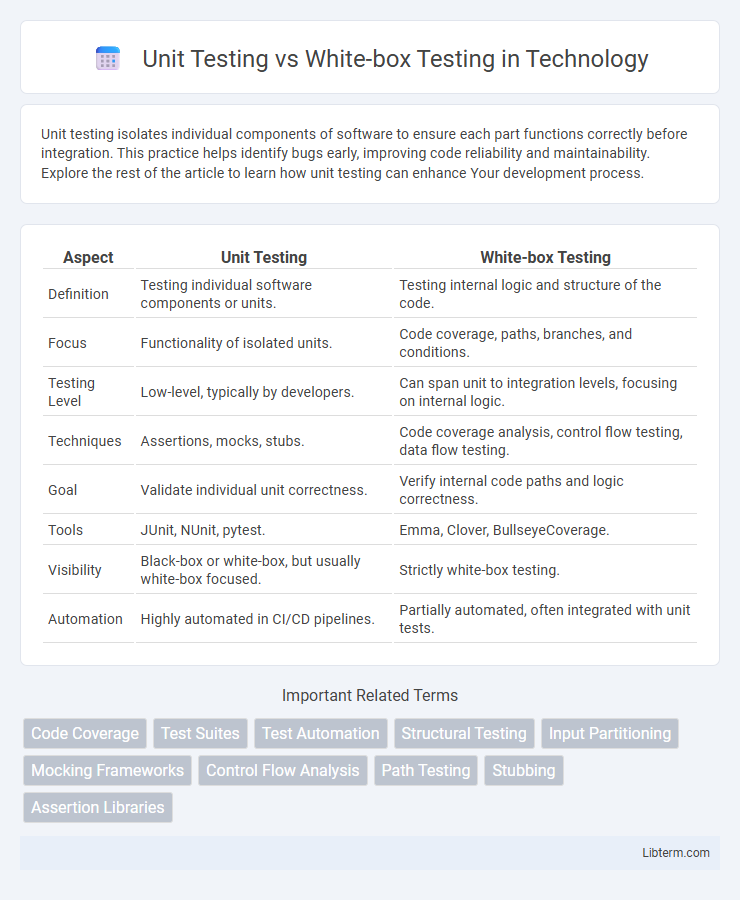Unit testing isolates individual components of software to ensure each part functions correctly before integration. This practice helps identify bugs early, improving code reliability and maintainability. Explore the rest of the article to learn how unit testing can enhance Your development process.
Table of Comparison
| Aspect | Unit Testing | White-box Testing |
|---|---|---|
| Definition | Testing individual software components or units. | Testing internal logic and structure of the code. |
| Focus | Functionality of isolated units. | Code coverage, paths, branches, and conditions. |
| Testing Level | Low-level, typically by developers. | Can span unit to integration levels, focusing on internal logic. |
| Techniques | Assertions, mocks, stubs. | Code coverage analysis, control flow testing, data flow testing. |
| Goal | Validate individual unit correctness. | Verify internal code paths and logic correctness. |
| Tools | JUnit, NUnit, pytest. | Emma, Clover, BullseyeCoverage. |
| Visibility | Black-box or white-box, but usually white-box focused. | Strictly white-box testing. |
| Automation | Highly automated in CI/CD pipelines. | Partially automated, often integrated with unit tests. |
Introduction to Unit Testing and White-box Testing
Unit Testing involves verifying the smallest testable parts of an application, called units, to ensure each functions correctly in isolation, typically focusing on individual functions or methods. White-box Testing examines the internal code structure and logic of the software, utilizing knowledge of the program's control flow, data flow, and algorithms to design test cases. Both techniques aim to increase code quality by detecting errors early, but Unit Testing is more granular, while White-box Testing provides comprehensive insight into internal workings.
Definitions: Unit Testing vs White-box Testing
Unit testing involves verifying the functionality of individual components or functions in isolation to ensure they work as expected. White-box testing examines the internal structure and logic of the code, typically requiring knowledge of the source code to design test cases. While unit testing can be performed using both black-box and white-box approaches, white-box testing specifically focuses on testing based on the internal code implementation.
Key Objectives of Each Testing Approach
Unit testing aims to verify the correctness of individual software components by isolating and testing each unit independently to ensure it behaves as expected. White-box testing focuses on examining the internal logic, structure, and flow of the code, validating paths, branches, and conditions to improve code coverage and detect hidden errors. Together, these approaches target functional verification at different granularities, with unit testing emphasizing functional output and white-box testing emphasizing internal code quality.
Methodologies and Techniques Compared
Unit testing isolates individual functions or methods to verify their correctness through black-box techniques such as input-output validation and boundary testing. White-box testing examines the internal logic and structure of code, employing methods like control flow analysis, statement coverage, branch coverage, and path testing. While unit testing emphasizes functional behavior without code inspection, white-box testing focuses on code internals, often integrating static analysis and code instrumentation for comprehensive test coverage.
Test Coverage Differences
Unit testing targets individual components or functions, ensuring each unit performs as expected with isolated inputs and outputs. White-box testing examines the internal logic and structure of the code, providing thorough coverage of code paths, branches, and conditions beyond the surface-level functionality. Test coverage in white-box testing is typically more comprehensive, measuring metrics such as statement, branch, and path coverage, whereas unit testing focuses primarily on verifying expected behaviors at the function or method level.
Tools Commonly Used in Unit and White-box Testing
Unit testing commonly utilizes tools like JUnit for Java, NUnit for .NET, and pytest for Python, which facilitate automated testing of individual code components. White-box testing tools often include code coverage analyzers such as JaCoCo, Cobertura, and BullseyeCoverage, enabling testers to examine internal code structures and verify paths within the source code. Integration of these tools provides comprehensive verification, ensuring both functional correctness at the unit level and thorough examination of internal logic in white-box testing scenarios.
Advantages and Limitations of Unit Testing
Unit testing offers precise code verification by isolating individual components, leading to early defect detection and simplified debugging. It enhances code maintainability and facilitates refactoring with immediate feedback but may miss integration issues since it tests units independently. Unit testing requires thorough test case design, and excessive focus on units can increase development time without guaranteeing system-wide reliability.
Pros and Cons of White-box Testing
White-box testing offers deep insights into the internal logic and structure of the code, enabling early detection of hidden errors and improving code coverage by examining all execution paths. However, it requires detailed knowledge of the codebase, which can be time-consuming and costly to perform, especially for large or complex systems. Unlike unit testing, which isolates specific functions or methods, white-box testing evaluates the entire program flow, making it more thorough but also more resource-intensive.
Best Practices for Combining Both Testing Types
Combining unit testing and white-box testing enhances software quality by ensuring both individual components function correctly and internal structures are validated. Best practices include designing unit tests that cover all code paths identified through white-box analysis, using code coverage tools to identify untested logic branches, and integrating automated test suites into continuous integration pipelines for consistent validation. Prioritizing test cases based on risk and complexity improves detection of defects early in the development lifecycle while maintaining test efficiency.
Conclusion: Choosing the Right Approach
Choosing between unit testing and white-box testing hinges on project requirements and testing goals. Unit testing excels in verifying individual components for functionality and early bug detection, while white-box testing offers comprehensive code coverage by examining internal structures, paths, and logic. Selecting the right approach depends on balancing the need for granular component validation against thorough code analysis to enhance software quality and maintainability.
Unit Testing Infographic

 libterm.com
libterm.com